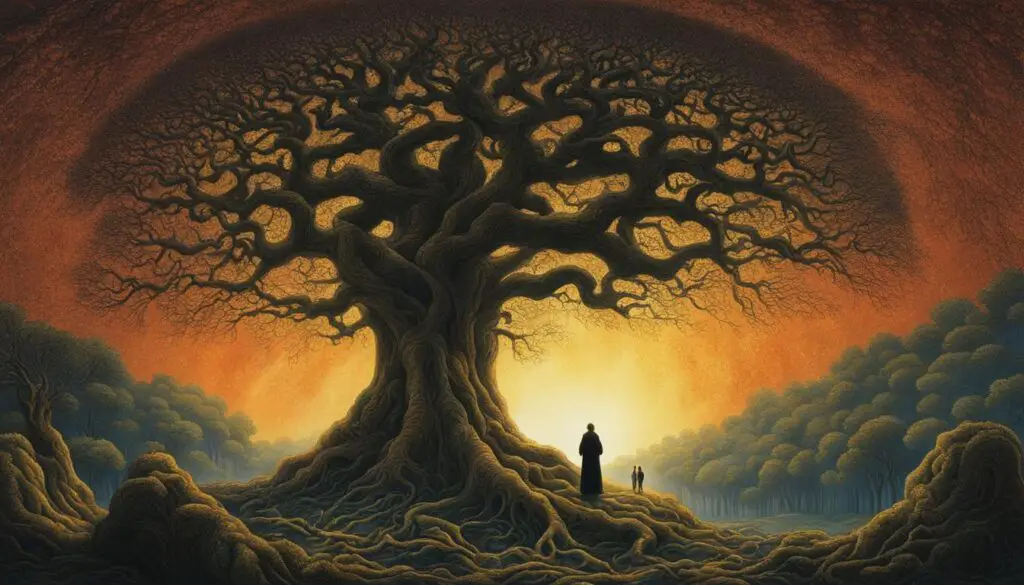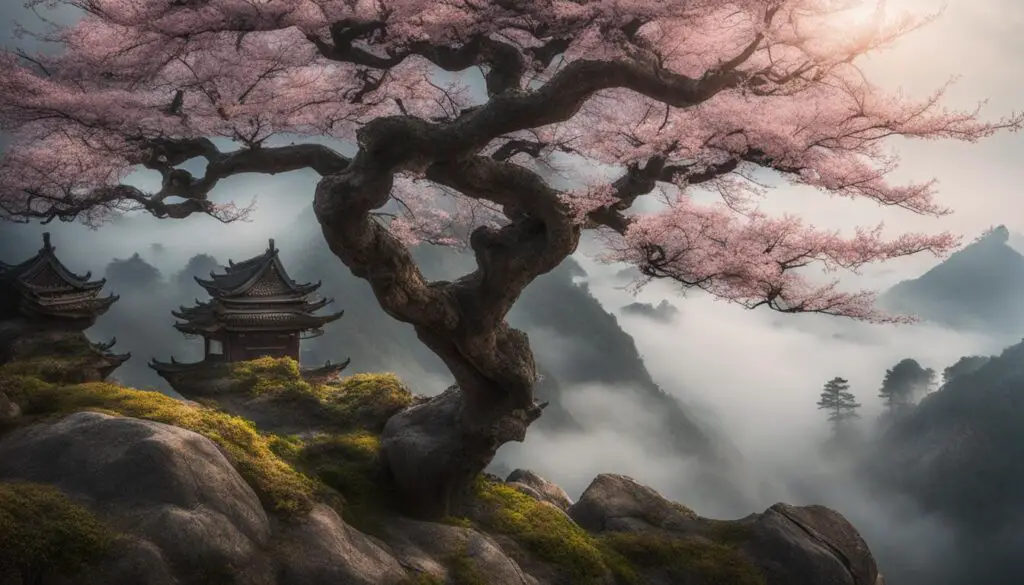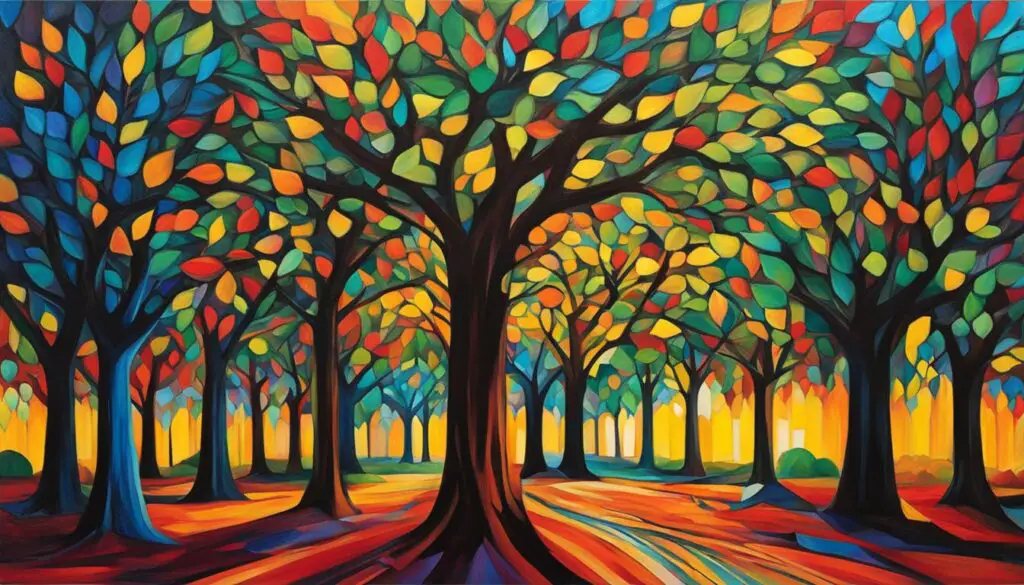Trees have played a significant role in cultures throughout history, symbolizing various meanings and representing spiritual growth, historical significance, and connection to nature. They are revered for their beauty, strength, and mystical powers, and are often seen as symbols of life, wisdom, power, and prosperity. Different cultures have their own interpretations of tree symbolism, with trees representing fertility, knowledge, liberation, and many other concepts. The symbolism of trees is found in mythologies, religions, and literature, showcasing the universal connection between humans and nature. Trees also have practical significance, providing oxygen for humans and creating a sense of awe and inspiration.
Key Takeaways:
- Trees symbolize various meanings and represent spiritual growth, historical significance, and connection to nature.
- They are revered for their beauty, strength, and mystical powers.
- Different cultures interpret tree symbolism differently, with trees representing fertility, knowledge, liberation, and more.
- The symbolism of trees is found in mythologies, religions, and literature, showcasing the universal connection between humans and nature.
- Trees provide practical significance in the form of oxygen for humans and inspiration in the form of awe-inspiring beauty.
The Universal Symbolism of Trees
Trees hold a universal symbolism that transcends cultural boundaries, connecting humans from diverse backgrounds to the natural world. They have been revered and worshiped in various cultures throughout history, symbolizing the deep connection between mankind and nature. Ancient and wise, trees are believed to possess mystical energy and wisdom, making them powerful symbols of physical and spiritual nourishment, transformation, liberation, union, and fertility.
The symbolism of trees has been ingrained in human history, playing an integral role in religious ceremonies, mythology, and spiritual practices. Their universal significance can be found in various cultural interpretations, representing concepts that are fundamental to the human experience. Whether it’s fertility, knowledge, liberation, or spiritual growth, trees embody deeply rooted meanings that resonate across cultures.
By emphasizing the universal symbolism of trees, we are reminded of our interconnectedness with nature and the profound significance that trees hold in our lives. They serve as a constant reminder of the beauty, wisdom, and vitality that the natural world offers, prompting us to appreciate and cherish the majestic presence of trees in our surroundings.
Symbolism of Trees in Different Cultures
The symbolism of trees extends beyond geographical and cultural boundaries. Here are some examples of how trees hold specific meanings in different cultures:
| Culture | Symbolic Meaning of Trees |
|---|---|
| Ancient Greece | Trees represented fertility, growth, and were associated with rituals and communication between worlds. |
| Norse Mythology | The World Tree Yggdrasil symbolized connection and stability between realms. |
| Hinduism | The banyan tree represented immortality and systems in life. |
| Buddhism | The Bodhi tree symbolized enlightenment. |
| Christianity | The Tree of Knowledge represented the journey from ignorance to knowledge. |
| Judaism | The Tree of Life symbolized life, continuity, and the connection between the divine and physical realms. |
The symbolism associated with trees in different cultures reflects the unique perspectives and beliefs of each society. These cultural interpretations serve as rich sources of inspiration, conveying stories of spirituality, wisdom, and the profound human experience.
Through their diverse manifestations in culture, literature, art, and personal relationships, trees continue to captivate and inspire us. Exploring the universal symbolism of trees allows us to appreciate the deep-rooted connection between nature and mankind, fostering a greater understanding and reverence for the profound role that trees play in our lives.
Trees in Mythology and Religion
Trees have played a significant role in mythology and religion throughout history. They hold great importance and are often worshiped and mythologized for their symbolic meanings. Trees symbolize growth, resurrection, and connection to the divine in various cultures. In many folk religions, trees are believed to be the homes of spirits, serving as a bridge between the earthly and spiritual realms.
Tree worship, also known as dendrolatry, has been a common practice in societies throughout history. Cultures across the world have revered and celebrated trees, recognizing their spiritual significance.
Tree symbolism is found prominently in mythologies and religions. For example:
- In Druidism and Germanic paganism, the Oak tree was highly revered and associated with wisdom, strength, and protection.
- In the Bible, the Tree of Knowledge played a central role in the story of Adam and Eve, representing the search for knowledge and the consequences of disobedience.
- In Buddhism, the Bodhi tree holds deep symbolism as the place where Siddhartha Gautama, the historical Buddha, found enlightenment.
The symbolism of trees in mythologies and religions continues to evolve and inspire new interpretations, reflecting the timeless connection between humans, nature, and the spiritual realm.

Cultural Symbolism of Trees
Trees hold specific meanings in different cultures, reflecting the unique perspectives of each society. Let’s explore the symbolism of trees in various cultural and religious contexts:
Ancient Greece
In Ancient Greece, trees were deeply revered and symbolized fertility, growth, and communication between worlds. Trees played a significant role in rituals and were believed to be inhabited by spirits. They were considered sacred and represented the connection between humans and the divine. The olive tree, in particular, held great symbolism and was associated with peace, wisdom, and victory.
Norse Mythology
In Norse mythology, the World Tree known as Yggdrasil stood at the center of the cosmos and symbolized the interconnectedness of all realms. It represented the stability and harmony between different worlds, serving as a cosmic axis. Yggdrasil was seen as the life force that sustained the entire universe, connecting humans, gods, and other mythical creatures.
Hinduism
The banyan tree holds immense significance in Hinduism and is considered sacred. Known as the Kalpavriksha or the “Wish-Fulfilling Tree,” it represents immortality and the cycles of life. Hindu scriptures describe it as a symbol of longevity, fertility, and abundance. The banyan tree is often associated with divinity and is believed to be the dwelling place of gods and goddesses.
Buddhism
In Buddhism, the Bodhi tree is highly revered as the place where Siddhartha Gautama, the founder of Buddhism, attained enlightenment. The tree symbolizes spiritual growth, awakening, and liberation from suffering. It represents the path of wisdom and the potential for enlightenment that exists within all beings.
Christianity
In Christianity, the Tree of Knowledge, often referred to as the Tree of the Knowledge of Good and Evil, is prominently featured in the book of Genesis. It represents the journey from innocence and ignorance to knowledge and moral discernment. The tree serves as a reminder of the consequences of disobedience and the human capacity to choose between good and evil.
Judaism
In Judaism, the Tree of Life holds deep symbolism and represents life, continuity, and the connection between the divine and the physical realms. It is often depicted in artwork and religious texts as a symbol of spiritual growth, nourishment, and the pursuit of righteousness. The Tree of Life serves as a reminder of the importance of living a meaningful and righteous life.
Trees in different cultures tell stories of spirituality, wisdom, and the human experience. Their symbolism resonates with people across different traditions and serves as a testament to the enduring connection between humans and nature.
Trees in Poetry and Literature
Trees have long been depicted in poetry and literature as powerful symbols. In ancient Chinese poems, willow trees were often used to convey emotions of farewell and longing. Different types of trees were used metaphorically to represent natural phenomena and human experiences. Pine and cypress trees, for example, were associated with sadness and death in old Chinese poetry.
Trees continue to inspire authors and artists, symbolizing growth, life, and the resilience of the human spirit. Their images evoke a sense of awe and can convey a wide range of emotions and meanings. From the majestic oak to the delicate cherry blossom, trees hold deep significance in literature, serving as powerful metaphors for the human condition and the beauty and complexity of nature.
One famous example of tree imagery in poetry is found in William Blake’s poem “A Poison Tree”. In this poem, the tree represents anger and resentment, growing and festering until it leads to devastating consequences. The use of tree symbolism in literature allows writers to tap into the universal understanding and connection to nature, enhancing the emotional impact of their work.
The representation of trees in Chinese poems is particularly noteworthy. Ancient Chinese poets used vivid imagery of trees to depict themes of nature, emotions, and philosophical concepts. The symbolic meaning of trees in Chinese poetry often reflects the cultural and historical context in which they were written.

For example, the willow tree is often associated with femininity, elegance, and grace. It is a common motif in Chinese poetry, representing the beauty of nature and the fragility of life. The image of a weeping willow evokes a sense of melancholy and longing, stirring deep emotions in the reader.
Furthermore, the concept of “Tree of Life” is also prevalent in many literary works. The tree symbolizes the interconnectedness of all living beings, the cycles of life and death, and the endurance of the human spirit. It represents the journey of self-discovery, growth, and transformation.
The symbolism of trees in literature is not limited to Chinese poetry. It can be found in works from various cultures and time periods, showcasing the enduring significance of trees in the human imagination. Whether in the form of a mystical forest, a solitary tree on a hill, or a small sapling amidst urban chaos, trees continue to captivate our hearts and inspire our literary endeavors.
Tree Symbolism in Relationships
Trees hold deep symbolic meanings in various relationships, representing the strength, wisdom, and connection shared between individuals. Across cultures, different trees are associated with specific relationships, highlighting the significance that trees play in familial bonds and human connections.
In Chinese culture, the Chinese Toon tree symbolizes fatherhood and embodies the qualities of strength and wisdom that fathers provide. This tree has a long lifespan, representing the enduring love and guidance that fathers offer to their children throughout their lives.
In Western culture, the oak tree is often used to symbolize fathers and their integrity. With its deep roots and strong branches, the oak tree represents the moral fiber and steadfastness that fathers bring to their families. It serves as a reminder of the importance of upholding values and being a source of support and protection.
The Chinese Redbud, on the other hand, holds symbolism for brotherhood and the bond between siblings. In literature and art, the Chinese Redbud is associated with the close relationship and camaraderie shared between brothers. It signifies the mutual support, shared experiences, and lifelong connection between siblings.
Trees serve as powerful symbols of love, connection, and familial relationships. They remind us of the deep-rooted bonds we share with our loved ones and the importance of nurturing and maintaining those relationships throughout our lives.
Trees as Symbols in Art and Film
Trees have long been a prominent subject in various forms of artistic expression, including paintings, sculptures, and films. These depictions often carry deep symbolic meanings, capturing the essence of the human experience and our connection to nature.
One of the most renowned symbols in art is the Tree of Life. Represented in countless paintings and sculptures, the Tree of Life embodies the interconnectedness of all living beings and the cycles of life and death. It serves as a powerful reminder of our place in the world and the enduring beauty of nature.
A notable example of tree symbolism in film can be found in the critically acclaimed movie “The Tree of Life.” Directed by Terrence Malick, the film follows the journey of a young boy as he navigates the complexities of life, love, and loss. The phoenix tree, depicted in the movie, becomes a profound symbol of rebirth and transformation, paralleling the protagonist’s personal growth and understanding of the interconnectedness of all things.

This image showcases the beauty and significance of tree symbolism in art and film.
| Art | Film |
|---|---|
| Tree of Life | “The Tree of Life” (2011) |
| A common symbol representing interconnectedness and the cycles of life and death in various cultural and religious contexts. | The phoenix tree serves as a powerful symbol of rebirth and transformation, reflecting the protagonist’s personal journey. |
The Significance of Trees Today
Trees continue to hold practical significance in our lives today. They serve as providers of oxygen and play a crucial role in maintaining a balanced ecosystem. The practical significance of trees cannot be overstated, as they contribute significantly to the well-being of our planet and its inhabitants.
One of the most vital roles trees play is their ability to produce oxygen through the process of photosynthesis. This biological process enables trees to convert carbon dioxide into oxygen, helping to purify the air we breathe. Additionally, trees absorb harmful pollutants, acting as natural air filters and improving the quality of the environment. As providers of oxygen, trees are essential for supporting life on Earth and combating climate change.
Furthermore, trees offer a unique and innovative approach to honoring the connection between humans and the natural world through the use of bio urns and tree burials. Bio urns provide a sustainable and eco-friendly alternative to traditional burial methods. These biodegradable urns contain tree seeds or saplings that can grow into a tree when buried, allowing the deceased to give back to the environment and become a part of the cycle of life. This practice not only promotes sustainability but also creates beautiful living memorials that celebrate the life of a loved one.
The significance of trees in our modern world extends beyond their practical value. They serve as a powerful symbol of our interconnectedness with nature and remind us of the importance of preserving natural resources. By maintaining a harmonious relationship with trees and the environment, we can ensure a sustainable future for generations to come.
Conclusion
Trees hold deep symbolism and significance in cultures worldwide, representing spiritual growth, historical importance, and our connection to the natural world. Their symbolism transcends cultural boundaries, highlighting the universal interconnectedness between humans and nature. Throughout mythologies, religions, and literature, trees symbolize life, wisdom, power, and prosperity, reminding us of our roots and potential for growth and transformation.
Beyond their symbolic meaning, trees continue to play a practical role in our lives. They provide the essential element of oxygen, sustaining human life and maintaining a balanced ecosystem. Additionally, trees offer innovative ways to honor our connection with nature, such as through tree burials and bio urns, allowing trees to grow and serve as enduring memorials.
Understanding and appreciating tree symbolism not only deepens our understanding of culture and history but also fosters a greater appreciation for the beauty and wisdom that trees offer us. By valuing the significance of trees in culture and life, we can strive to preserve and protect these magnificent beings for future generations.
FAQ
What do trees symbolize in culture and life?
Trees symbolize various meanings in different cultures, representing spiritual growth, historical significance, and a connection to nature. They are often seen as symbols of life, wisdom, power, and prosperity.
What is the universal symbolism of trees?
Trees hold universal symbolism, reflecting the interconnectedness between humans and nature. They symbolize physical and spiritual nourishment, transformation, liberation, union, and fertility.
How are trees represented in mythology and religion?
Trees are often worshiped and mythologized in various cultures, symbolizing growth, resurrection, and connection to the divine. They are believed to be homes for spirits and play significant roles in religious ceremonies and spiritual practices.
What is the cultural symbolism of trees?
Trees hold specific meanings in different cultures. For example, in Ancient Greece, they represented fertility and growth, while in Norse mythology, the World Tree symbolized connection and stability. Trees have unique symbolism in Hinduism, Buddhism, Christianity, and Judaism, representing concepts such as immortality, enlightenment, and the connection between divine and physical realms.
How are trees symbolized in poetry and literature?
Trees have been depicted in poems and literature as symbols of growth, life, and the resilience of the human spirit. Different types of trees often convey specific emotions and represent natural phenomena or human experiences.
What do trees symbolize in relationships?
Trees symbolize various relationships in different cultures. For example, the Chinese Toon tree represents fatherhood and strength, while the oak tree in Western culture is associated with strong moral fiber and represents fathers and their integrity.
How are trees used as symbols in art and film?
Trees have been widely represented in various forms of art, including paintings, sculptures, and films. The Tree of Life is a popular symbol in art, representing the interconnectedness of all living beings and the cycles of life and death.
What is the significance of trees today?
Trees play a crucial role in our lives today by providing oxygen and maintaining a balanced ecosystem. They also serve as memorials through practices like tree burials and the use of bio urns, honoring the connection between humans and trees.
What is the conclusion of tree symbolism?
Trees hold deep symbolism and significance in culture and life. They represent spiritual growth, historical significance, and our connection to the natural world. Tree symbolism is diverse and rich in various cultures, reminding us of the importance of preserving natural resources and our harmonious relationship with nature.

